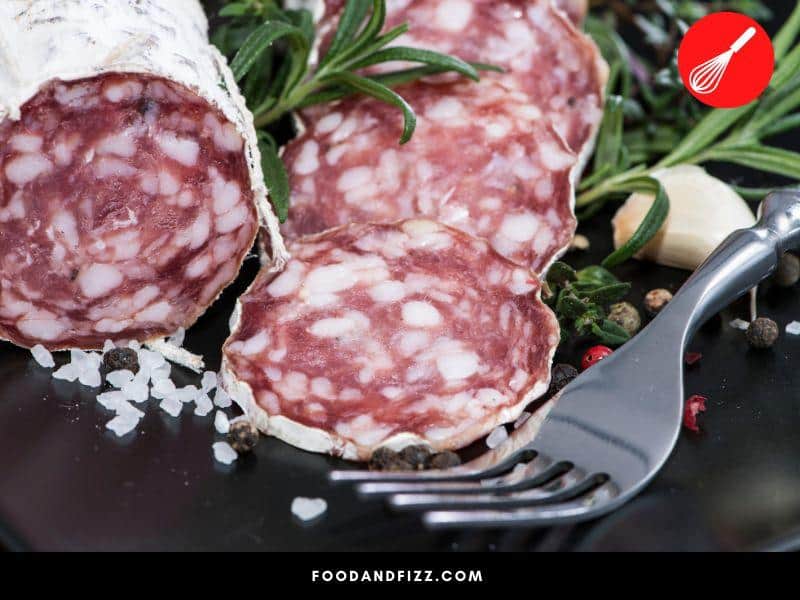Salami is a popular type of cured meat that is versatile and loved by many. They can be served cooked or uncooked, enjoyed on their own, or added to dishes to enhance flavor and texture.
Perhaps the most popular type of salami, pepperoni, is a favorite pizza topping in America.
Can You Eat Uncured Salami?
You can eat uncured salami. Uncured salami is similar to regular, cured salami, except that it is processed and preserved using naturally-derived nitrates and nitrites as opposed to chemical curing salts. Both are safe to eat when prepared properly and can be consumed similarly.

What Is Uncured Salami?
Contrary to what the term implies, “uncured” salami is not truly uncured. Rather, it is salami that has been cured using curing agents that are naturally derived, such as salt and celery or beet powder, as opposed to salami that has been cured using synthetic curing salts.
Using plant extracts that have naturally occurring nitrates that can be broken down into nitrites, manufacturers cure “uncured salami” in much the same way that regular, cured salami is processed.
Thus, cured salami and uncured salami are similar in that both contain nitrates and nitrites, except the source of those nitrates and nitrites in uncured salami is naturally produced.
Up until recently, the USDA requirement actually stated that meats that are cured without the use of known curing agents (aka synthetic agents) should be labeled as “uncured”, although some groups have petitioned to change this requirement as it can be misleading since both cured and so-called uncured salami still both contain highly controversial nitrates and nitrites. The USDA has partially granted this request in 2020.

Is It Safe To Eat Uncured Salami?
Uncured salami, like cured salami, is safe to eat, as long as they are properly cured and processed.
It is important to always source from reputable sources to ensure that your cured meat is safe to eat as improperly prepared and stored meats can lead to a host of food-borne illnesses.
Cured Vs. Uncured Salami
Cured and uncured salami may seem very different, with the latter one giving the impression that it is healthier and less processed. But is this really the case?
We’ll explore below.
1. Ingredients
Cured and uncured salami typically use the same type of raw ingredients and spices. However, uncured salami only uses natural preservatives and not chemical ones.
Cured salami, on the other hand, uses other ingredients and food-safe chemicals to help preserve it. Because uncured salami is “limited” in this way, it can contain more salt than its cured counterpart.
2. Method of Curing and Preservation
This is the main difference between cured and uncured salami. Cured salami is processed and preserved using chemical additives and synthetic curing salts to achieve the final, cured product.
Uncured salami, on the other hand, is processed using natural preservatives derived from celery powder, beet powder, or other plants to achieve the desired outcome.
Up until recently, the USDA required meat to be labeled as “uncured” if it is made without any of its recognized curing agents, however, advocate groups have petitioned for this to be changed since it can be misleading to consumers. The USDA partially granted this request in 2020 to improve labeling regulations.
In short, “uncured” salami is still cured, except that the substances used for curing it is derived from natural sources or does not include any of the standard curing agents recognized by the USDA.
This means that nitrates or nitrites will still be present in the product, except that those in the uncured version will just be produced or derived naturally, and not chemically manufactured.
The final end product will still be quite similar.
3. Taste and Appearance
Due to the different types of curing agents added, cured and uncured salami may sometimes take on a different appearance.
Cured salami that’s processed with traditional curing salts or chemical agents may be a darker red or pink color, while uncured salami may be paler pink in color.
Cured meat may also have a more intense flavor than uncured meat.
4. Shelf Life
Both cured and uncured salami need to be refrigerated to extend shelf life and make them last longer, however, uncured salami tends to have a shorter shelf life due to the absence of chemical preservatives.
To put it simply, there really is no truly “uncured” salami. Both cured and those labeled as “uncured” salami are still cured, fermented, and dried. The difference lies mainly in what curing agents are used.
It is also similar to pepperoni. Uncured pepperoni and cured pepperoni are both still cured, except with different curing agents. Read Uncured Pepperoni vs Cured – The Important Difference.
What Is Salami?
Salami is a cured and fermented sausage that is typically and traditionally made with pork, although nowadays, salami can also be made with beef, lamb, duck, sheep, goat, and other types of meat.
The word “salami” comes from “sale”, the Italian word for salt, and gives us a clue as to how this type of meat is prepared.
Along with ground or coarsely ground meat, other ingredients like garlic, salt, herbs, spices and other seasonings, vinegar, and wine are added to the mix that is encased and then left to dry and cure.
The resulting sausage is very distinctive in flavor and taste and can be consumed as is or further cooked, as the star of the meal, as part of a charcuterie board, or as a topping or enhancement to other dishes.

How Is Salami Made?
In general, salami is made in the following way:
Step 1: The Meat Is Prepared
Raw meat, usually pork, is finely ground or coarsely ground using a meat grinder. Various cuts of pork, a mixture of meat and fat, is typically used as opposed to just one cut of pork.
As with anything in cooking, good quality meat ensures a good quality end product.
Step 2: Ground Meat Is Salted and Flavored
Once the meat is ground, the salt, herbs, spices, and various seasonings are added to the mix. The salt prevents bacteria from spoiling the meat, and acts as a preservative.
Curing agents, chemical or natural, are also added at this point. In cured salami, these can be added nitrates or nitrites that are chemically manufactured and produced that aid the meat in the curing process and give them that characteristic red to pink hue and helps them develop their flavor.
These curing agents are also added as they are said to give an extra layer of protection to meat from bacteria like Clostridium botulinum, the bacteria that causes botulism, which can render the meat toxic.
Curing salt, also sometimes called “pink salt” (not to be confused with Himalayan pink salt, which is naturally pink), is a mixture of sodium chloride (table salt), sodium nitrite, and a red dye to make sure they are not confused with regular table salt.
It is what gives cured meats their typical pink to red color. This is because the nitrites react with proteins in the meat and prevent oxidation, thus keeping the meat pink in color. Curing salts also give cured meat its cured flavor.
In uncured salami, natural curing agents are used as an alternative, usually powder or juice from celery or beets. Nitrates (which are broken down to nitrites by bacteria), are naturally occurring in these vegetables as well as most leafy and root vegetables.
These natural nitrates also break down into nitrites with the help of bacteria, and they do the same action on the meat as chemically added and chemically produced nitrates and nitrites.
Step 3: Meat Is Stuffed Into Casings
After the seasonings and curing agents have been added, the meat is then filled into the casings, whether cleaned animal intestines or natural or synthetic casings. For vegetarian sausages, vegetarian sausage casings also exist.
The sausage is filled and stuffed tightly and tied properly with twine.
Step 4: Fermentation
After this, the salami is ready for fermentation. In modern salami production, the salami is placed in a warm, humid place for a couple of days to encourage and jumpstart the process of fermentation, before placing them in a cool place with controlled temperatures to slowly dry them.
The more traditional way of making salami skips the first step of hanging the sausages in a warm environment and immediately ferments them in a cool, temperature-controlled environment.
This process is very important as the proper balance of bacteria and the lactic acid they produce plays a big role in the development of the final flavor of the salami.
Proper fermentation also ensures that the meat will not spoil and will be safe to eat.

Step 5: Drying
After fermentation, the salami is then dried. This means that time is allotted so that the water from the center of the sausage log is drawn out through the natural process of osmosis.
When the water has mostly dried out, the salami can then be packaged. The longer it is dried, the harder the salami becomes.
Like the fermentation process, the process of drying requires much care and skill, too, as improper drying may lead to unwanted tastes and textures and may render the meat unsafe for consumption.
From raw ground meat to fully cured sausage, salami goes through a careful, multi-step process of curing to ensure that the salami we have on our tables is delicious and safe to eat.
Is Uncured Salami Healthier Than Uncured Salami?
Except for the use of naturally derived ingredients in curing, uncured salami and cured salami are not that much different in terms of their nutritional profile.
Both uncured and cured salami are made from the same types of ingredients, usually, pork, which has its health benefits.
Both are cured and fermented products which have nitrates and nitrites in them, which are controversial components in food as they have been linked to diseases like cancer.
Another issue with cured meats is their high sodium content, which have been linked to high blood pressure and is a precursor to other diseases like heart disease.
When consumed in moderate and reasonable amounts though, they may be added to a reasonably healthy diet.
Thus, save for a few differences, cured salami and uncured salami are not really that much different from each other, and we cannot fully claim that uncured salami is superior to cured salami.
However, if you prefer that your salami is cured using natural ingredients, then uncured salami is definitely the way to go.

Frequently Asked Questions To Can You Eat Uncured Salami?
What Is Cured Salami?
Cured salami is meat, usually pork, that has gone through a process of curing, fermentation and drying. Usually, apart from salt, synthetic agents are added to aid in the curing process and to help prevent the meat from spoiling. These curing agents help give cured salami its characteristic flavor and color.
Is Salami Bad for You?
Salami is a cured meat, which means it is high in sodium. A diet high in sodium can lead to serious health issues. Salami and other cured meats also contain nitrates and nitrates that when consumed in large amounts, may lead to serious health issues.
Conclusion to Can You Eat Uncured Salami?
It is safe to eat uncured salami, provided that it was sourced and prepared properly.
“Uncured”, at least in the U.S., does not mean unprocessed or heathier salami. It simply means that the salami was cured using naturally-derived curing ingredients as opposed to chemically produced, synthetic ones.

